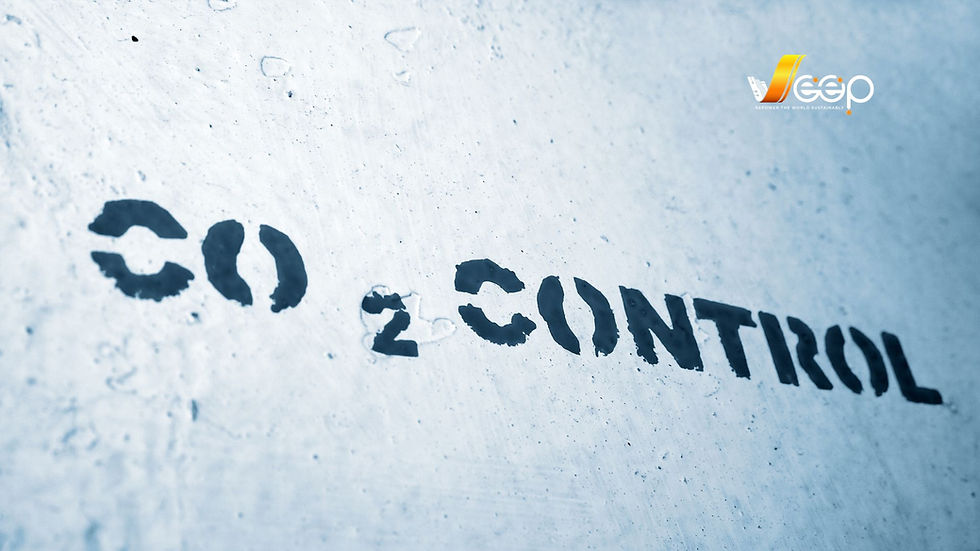What is 𝗖𝗮𝗿𝗯𝗼𝗻 𝗘𝗺𝗶𝘀𝘀𝗶𝗼𝗻𝘀?
- thaotran11
- 25 thg 3
- 4 phút đọc
This refers to the release of carbon dioxide into the atmosphere. It can also encompass other greenhouse gas (GHG) emissions when quantified and converted into CO2e, a standard metric for measuring environmental impact.
Carbon Emissions: The Invisible Driver of Planetary Crisis
Beneath the hum of modern civilization lies a silent, accumulating threat: carbon emissions. These emissions—primarily carbon dioxide (CO2) but also methane, nitrous oxide, and fluorinated gases—act as an atmospheric blanket, trapping heat and destabilizing Earth’s climate systems.
Yet, their impact extends far beyond rising temperatures. From reshaping economies to redefining global security, carbon emissions sit at the center of humanity’s most pressing challenges.

The Anatomy of Carbon Emissions
Carbon emissions refer to the release of CO2 and other greenhouse gases (GHGs) into the atmosphere, primarily from human activities. To standardize their environmental impact, non-CO2 gases like methane—28–36 times more potent than CO2 over a century—are converted into carbon dioxide equivalent (CO2e), a metric critical for quantifying global warming potential.
The majority of emissions stem from energy production, industry, and transportation. Burning fossil fuels for electricity and heat dominates, accounting for 35% of global CO2 emissions, with coal-fired power plants contributing over 20%. Industrial activities, including cement, steel, and chemical manufacturing, release CO2 through energy-intensive processes and chemical reactions, responsible for nearly a quarter of emissions. Transportation, particularly cars, ships, and planes reliant on oil, emits 16%, with aviation’s share growing faster than any other sector.
Natural processes like wildfires and permafrost thaw also emit GHGs, but human activity has amplified these sources. Since the Industrial Revolution, atmospheric CO2 levels have surged from 280 parts per million (ppm) to 423 ppm in 2024—a concentration unseen in 4 million years.
Why Carbon Emissions Defy Borders
Unlike localized pollutants, carbon emissions diffuse globally, creating a paradox: the countries least responsible often suffer the gravest consequences. The G20 nations generate 80% of global emissions, yet small island states like Tuvalu face existential risks from sea-level rise. This inequity fuels debates over climate justice, with developing nations demanding compensation for “loss and damage” at forums like COP28.
Emissions also linger for centuries. CO2 remains in the atmosphere for 300–1,000 years, meaning today’s decisions will shape climates for generations. The 2023 IPCC report underscores that even if emissions halted tomorrow, past emissions would continue warming the planet for decades.

Measuring the Immeasurable: From Satellites to AI
Accurately tracking emissions is a scientific and logistical frontier. Traditional methods rely on self-reported data from industries, but discrepancies are common. Cutting-edge tools now fill these gaps. Satellite monitoring systems like NASA’s Orbiting Carbon Observatory 3 and the European Space Agency’s Sentinel-5P map CO2 and methane plumes in real time, exposing underreported emissions from oil fields and landfills.
AI-powered analytics, such as those developed by startups like CarbonChain, use machine learning to estimate emissions across supply chains—from a ton of steel to a shipment of avocados. Networks of atmospheric sensors, including ICOS (Integrated Carbon Observation System), provide granular data on regional emission sources, aiding policymakers in targeting reductions. Despite these advances, nearly 30% of global emissions lack reliable measurement frameworks, particularly in agriculture and informal waste management.
The Race to Decarbonize: Successes and Setbacks
Global emissions reached a record 58.6 gigatons of CO2e in 2023, but progress is emerging. Renewable energy adoption has slowed emission growth, with solar and wind now cheaper than coal in most countries. Nations like Denmark and Uruguay generate over half their electricity from renewables, while corporations like Maersk and Microsoft invest billions in carbon-neutral technologies.
Yet, the path remains fraught. The post-pandemic surge in coal use, geopolitical tensions disrupting clean energy supply chains, and rising methane leaks from aging oil infrastructure threaten short-term goals. The International Energy Agency warns that without tripling renewable capacity by 2030, limiting warming to 1.5°C will be impossible.

Beyond CO2: The Methane Time Bomb
While CO2 dominates headlines, methane—responsible for 30% of current warming—demands urgent attention. Over 80% of methane emissions come from fossil fuel operations, livestock, and rice paddies. The Global Methane Pledge, signed by 150 countries, aims to slash methane by 30% by 2030. Innovations like methane-eating bacteria and satellite-guided leak detection in oil fields offer hope, but enforcement remains patchy.
Carbon Emissions in a Net-Zero World
The endgame is clear: reduce emissions to “net zero,” where remaining releases are balanced by removals. This requires phasing out fossil fuels, electrifying industries, and scaling carbon capture technologies. However, net-zero pledges vary wildly in credibility. A 2023 UN report found that 90% of corporate net-zero plans lack interim targets or robust carbon removal strategies, risking empty promises.
Carbon pricing mechanisms—taxes or cap-and-trade systems—are gaining traction to incentivize cuts. The EU’s carbon price hit €100 per ton in 2023, pushing utilities toward renewables. Meanwhile, developing nations advocate for financial support, as seen in the landmark Loss and Damage Fund established at COP28.
Carbon emissions are both a metric of planetary harm and a mirror reflecting humanity’s priorities. They reveal the tension between economic growth and ecological survival, between present convenience and future viability. While technology and policy tools exist to curb emissions, their success hinges on something harder to quantify: collective will.
As climate scientist Katharine Hayhoe reminds us, “The biggest hurdle isn’t science—it’s storytelling.” Translating gigatons into human narratives—of communities displaced, species lost, and innovations born—may finally turn the tide. The emissions crisis is a problem of our making, but so too is the solution.
#ESG; #LOW_CARBON; #JODIN; #VIoT; #VEEP; #GIAI_PHAP_NANG_LUONG_SACH; #NETZERO; #NANG_LUONG_XANH; #TOA_NHA_XANH; #NHÀ_MAY_XANH; #SMART_INDUSTRIAL_4; #SMART_BUILDING; #FOOT_CARBON; #CARBON_FOOT; #GREENHOUSE_GAS_EXPERT; #CARBON_ROADMAP; #GRI; #SASB; #DJSI; #SAVING; #LIGHTING; #CHILLER; #ENERGY_EFFICIENCY; #AMIGO; #SOLAR; #BEES; #STORAGE; #REAL_TIME; #EeaaS; #LaaS; #EaaS; #SUSTANABILITY; #RENEWABLE; #SMART_LIGHTING; #MANAGEMENT; #OPTIMIZATION; #ENERGY; #EFFICIENCY; #ESG; #LaaS; #EEaaS; #EaaS; #ESaaS
.png)